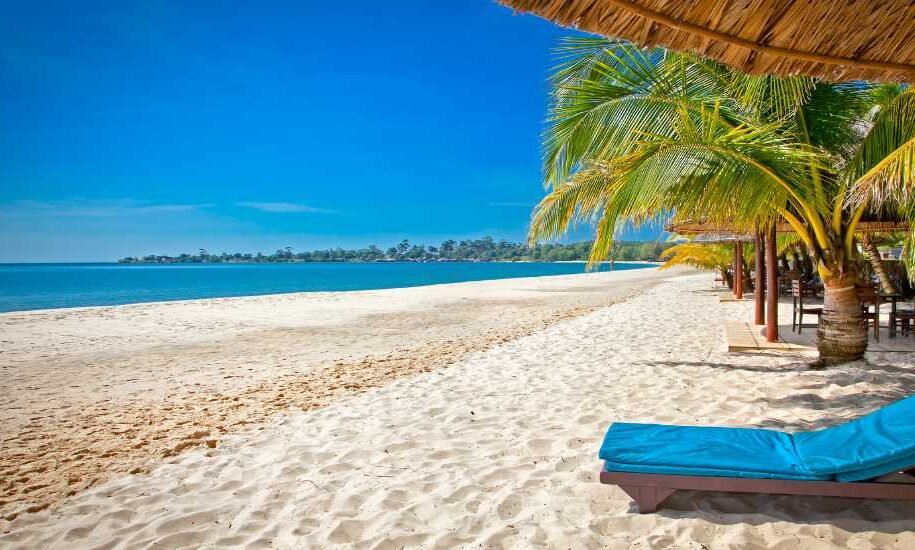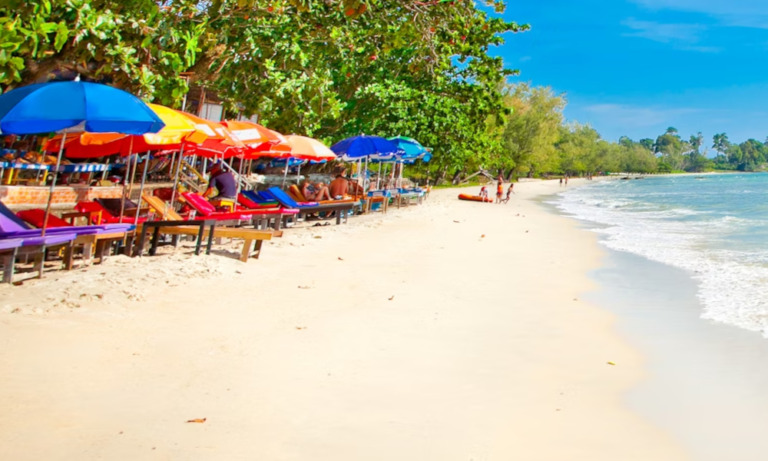The Cambodia Lush Beach - Sihanouk Ville

Sihanoukville serves as the entertainment hub of Cambodia. Boasting extensive mainland beaches and nearby undeveloped islands, it stands as the nation’s foremost beach destination. The rise in direct flights from Phnom Penh has led to an influx of tourists in recent years, which is evident in the surge of hotels, bars, and restaurants.
Table of Contents
ToggleGeography
Sihanoukville is positioned in the southwestern region of Cambodia, along the Gulf of Thailand, and is located on a peninsula that is divided from the central plains of the country by the Damrei Mountains, which translates to the ‘Elephant Mountains.’ It ranks among the smallest provinces in Cambodia, bordered to the north and west by Koh Kong province and to the east by Kampot. The coastline of Sihanoukville features over a dozen small islands, the majority of which can be reached within a few hours by local boat. Additionally, the mainland boasts several sandy beaches.
Sihanoukville Attractions
The primary allure of Sihanoukville lies in its natural surroundings. The coastline features several beaches that attract both international and local tourists.
1- Beaches
- Otres Beach is arguably the most tranquil and picturesque stretch, characterized by a limited number of restaurants and shops. Located just around the headland from Sihanoukville town, it is often favored by those seeking a peaceful experience by the sea and sand.
- Occheuteal Beach is known for its vibrant nightlife, with numerous restaurants and bars. While some visitors now consider it overly crowded and noisy, it remains an excellent destination for an enjoyable evening out. The upper section of this beach is referred to as Serendipity Beach, which hosts guesthouses directly on the shore. This area is particularly lively and primarily attracts backpackers.
- Victory Beach was once the most favored party destination but has seen a decline in popularity compared to Occheuteal Beach in recent years. Regrettably, it has become associated with sex tourism during the evenings, leading many to find the area less appealing.
- Independence Beach features a 500-meter stretch of sandy shoreline adorned with deck chairs and a few barbecue stalls. Although the beach extends further, a portion is currently undergoing development. Nevertheless, Independence Beach remains significantly quieter than many other locations, and a small island is situated just off the coast at its northern end.
2- Islands
- The islands situated near Sihanoukville are increasingly regarded as superior beach destinations compared to the mainland coast, primarily due to their relatively undeveloped nature. For those seeking a secluded island getaway, these islands present an ideal choice.
- Koh Rong stands out as the largest and most developed island, with future plans for an airport.
- Another highly favored island is Koh Rong Saloem, located slightly farther from the coast, featuring a more established infrastructure for visitors while still retaining its unspoiled charm.
- It is important to mention that while most islands have guesthouses, many of these accommodations are quite basic, often comprising bamboo bungalows along the beach and a limited number of dining options. Some locations provide services such as massages, snorkeling, or boat excursions, but overall activities are scarce. A vacation on one of these islands is truly designed for those desiring a retreat from contemporary life, offering only the essentials of sun, sea, and sky.
3- Other attractions
- The town center of Sihanoukville is not particularly noteworthy, having developed primarily around the import/export sector and beach tourism. It features several guesthouses and a considerable number of Western dining establishments.
- Easily accessible from Sihanoukville is Ream National Park, which shelters various protected bird species and features mangrove channels. The park also provides excellent trekking opportunities through its mountainous and forested areas.
Getting around
The demographic composition of Sihanoukville initially consisted primarily of construction workers and their families engaged in the development of the port. Interestingly, only half of the families residing in the area are involved in rice farming, while the remaining 50% of the population, which totals around 200,000, is employed in various service sectors.
Navigating Sihanoukville typically requires the use of some form of transportation, as the distances can range from being easily walkable to quite challenging. Fortunately, although public transport options are somewhat limited, they are readily accessible and economical, making travel between beaches and key attractions relatively straightforward.
It is crucial to understand that public transportation in Sihanoukville does not utilize meters; therefore, it is necessary to negotiate a fare prior to departure. It is advisable to confirm the price beforehand and to engage in some bargaining if desired. While fares may be slightly elevated for longer journeys or nighttime travel, they remain generally low, and drivers typically do not attempt to overcharge tourists.
Weather
The climate in Sihanoukville resembles that of many other regions in the country. It is important to highlight that the rainy season at a coastal resort can be rather inconvenient, and other regions are generally more favorable for visits from July to September. Additionally, this area experiences significant rainfall due to weather systems originating from the sea and its closeness to the Damrei Mountains. The optimal period for a vacation here is from November to February, characterized by dry and sunny conditions that are pleasantly warm. Conversely, from March to June, the heat may be excessive for sunbathing and beach activities.
Economy
Due to the critical role of exports in Cambodia’s economy, the local government, along with international financial assistance, has designated Sihanoukville and its port for substantial future development.
While Sihanoukville is predominantly reliant on tourism, there are also ongoing efforts to enhance financial and industrial activities. A key objective of the government is to establish Sihanoukville as a leading tourist destination and an International Offshore Financial Centre. Both foreign and domestic investors are encouraged to engage in various joint business and financial initiatives. The agricultural sector in Sihanoukville does not significantly contribute to the provincial economy, as the rocky peninsula is not conducive to farming and similar activities.
Conclusion
Sihanoukville, Cambodia, has been the focus of various assessments, highlighting the necessity for a sustainable development strategy, the importance of regulating foreign business operations, and the imperative to tackle environmental offenses.
As Sihanoukville has significantly advanced in various areas such as trade, tourism, and other sectors, the road connecting it to Phnom Penh required a comprehensive reconstruction. Travelers can now enjoy the well-maintained National Highway No. 4, which spans 230 kilometers and links the capital to this coastal destination.
Additionally, access to the province can be gained directly from Koh Kong Province, which borders Thailand, a route increasingly favored by tourists. This can be accomplished via the rugged Major Road 48 that skirts the Cardamom Mountains or by taking a speedboat from Koh Kong town, situated adjacent to the Thai border.
Bus and Van Services:
Numerous bus companies, including Giant Ibis, Mekong Express, PSD Xpress, Sorya Bus, Neak Krohorm, Thero Express (15-seat), Larryta, KSO, Virak Buntham, Kampot Express, and Cambodia Post VIP Van, provide transportation services to Sihanoukville. These companies operate modern, air-conditioned buses and vans, with departures scheduled every 15 minutes to one hour from 6 AM to midnight. The fares are quite reasonable, and online bus tickets can be purchased in advance.
Shared Taxis:
Most shared taxis leave Phnom Penh before 10:00 am, although options may still be available in the early afternoon. The fare typically ranges from $3 to $5 per person. These shared taxis provide a cramped and uncomfortable journey, often accommodating eight or more passengers in a small vehicle. In contrast, private taxis cost approximately $20 to $25. In Phnom Penh, taxis can be found waiting at the southwest corner of the Central Market (Phsar Thmey), while in Sihanoukville, taxis heading to Phnom Penh are located on Street 108.
It is now quite convenient, to reserve a private taxi online before your arrival.
Boats:
Daily boat services depart from Sihanoukville around noon for Krong Koh Kong, with a fare of 500 Baht for a journey lasting approximately four hours. Unfortunately, most foreigners are charged 600 Baht or $15. The trip is worthwhile, as it offers views of pristine beaches and beautiful coastal landscapes.
Motorbike Information:
The journey on National Highway No. 4 spans 230 km and takes about 4 to 5 hours, with a minimum engine capacity of 200cc. Motorcycles can be rented from Lucky Lucky Motorcycle on Monivong, near Street 184 in Phnom Penh, or from Angkor Motorcycles on Street 51, close to the well-known Walkabout Bar. While this mode of transport is quick and convenient, it can also be quite hazardous due to speeding taxis and reckless trucks. It is advisable to reduce speed in villages and remain vigilant for slow-moving animals and unaware children. Always wear a helmet, and be aware that medical assistance and rescue services are nearly nonexistent in rural areas.
By Air:
There are two daily flights from Siem Reap to Sihanoukville, operating in the morning and afternoon. Direct flights from Ho Chi Minh City to Sihanoukville are also available.

